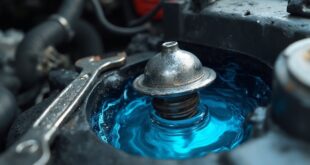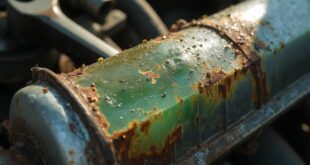If one of your low beam headlights isn't working, it's likely due to a bad bulb, a corroded socket, or a blown fuse. Check for a dim or flickering light, which often points to a bad bulb. You could also inspect the bulb socket for corrosion and confirm the fuses are in good condition. Don't worry; there are more details you can explore to troubleshoot this issue effectively.
Common Causes of Low Beam Headlight Failure
One of the main reasons for low beam headlight failure is a bad bulb, which is the most common culprit.
Bulbs have a limited lifespan, and halogen bulbs tend to burn out faster than Xenon or LED options. If your low beam's not working, it's often necessary to replace the burnt-out bulb.
Another issue could be using the wrong bulb type, which can prevent proper illumination. Additionally, a bad or corroded bulb socket can disrupt the connection.
Checking for a blown fuse or damaged wiring is also essential, as these can lead to similar issues with your low beams.
Identifying a Bad Bulb
How can you tell if your low beam headlight bulb is bad? Start by checking for dim or flickering light. You might also notice a dark spot on the bulb or a burnt filament when inspecting it. Here's a quick reference table to help:
| Signs of a Bad Bulb | Next Steps |
|---|---|
| Flickering or dim light | Replace the bulb |
| Burnt filament | Inspect and replace |
| Dark spots on the bulb | Check connections |
| No light at all | Test with a new bulb |
If you find any of these signs, it's time to replace your bulb!
Understanding Wrong Bulb Types
Choosing the right bulb type for your low beam headlights is essential for ensuring proper illumination. If you've installed the wrong bulb, it simply won't work, regardless of how new it is.
Different vehicles require specific bulb types, and mixing them up can lead to compatibility issues. To avoid this, always check your vehicle's manual or consult a reliable source before purchasing replacements.
Incorrect installation can also cause problems, so make sure you're following the manufacturer's specifications.
Assessing Bulb Socket Condition
Before replacing your low beam headlight bulb, it's important to assess the condition of the bulb socket. A corroded or damaged socket can prevent the bulb from functioning properly.
Here are three key things to check:
- Corrosion: Look for any signs of rust or buildup, which can hinder electrical connection.
- Physical Damage: Inspect the socket for cracks or broken pieces that may affect fitment.
- Cleanliness: Verify the socket is free of dirt and debris for peak performance.
Addressing these issues can save you time and money in the long run, guaranteeing your headlights work effectively.
Checking for Blown Fuses
When your low beams aren't working, checking for blown fuses is an essential step in diagnosing the issue.
Start by locating your vehicle's fuse box, usually found under the dashboard or in the engine compartment. Refer to the fuse box cover or your owner's manual to identify the low beam fuses.
Use a fuse tester or visually inspect each fuse to see if any are burnt. If you find a blown fuse, replace it with one of the same rating.
This quick and inexpensive fix can often restore your low beams to working order, so don't overlook it!
Inspecting Damaged Wiring
Inspect damaged wiring by visually examining the wires that connect your low beam headlights to the electrical system. Look for any signs of wear or breakage, as this can lead to flickering or complete failure.
If you suspect damage, consider these steps:
- Check for fraying – Look closely for exposed wires or frayed edges.
- Examine connectors – Verify all connectors are secure and free from corrosion.
- Test for continuity – Use a multimeter to confirm that electricity flows through the wiring.
Address any issues immediately to prevent further damage and guarantee your headlights function properly.
Steps to Replace a Bulb
Replacing a low beam headlight bulb is a straightforward task that can be completed in just a few minutes.
First, make certain your vehicle is off and the keys are removed. Open the hood and locate the headlight assembly.
Carefully remove the old bulb by twisting it counterclockwise. Avoid touching the glass of the new bulb with your fingers; use gloves or a cloth instead.
Insert the new bulb into the socket and twist it clockwise to secure it.
Finally, test the headlight to verify it's working properly. If it is, close the hood and you're good to go!
Cleaning and Maintaining Bulb Sockets
Although it's easy to overlook, cleaning and maintaining bulb sockets is essential for ensuring your headlights function properly. Corrosion can build up over time, affecting the electrical connection.
Here's how to keep your bulb sockets in top shape:
- Turn off the lights and remove the bulb before cleaning.
- Use electrical contact cleaner to remove corrosion, and for heavy buildup, gently scrape with a wire brush.
- Ensure the socket is dry before reinserting the bulb to prevent moisture-related issues.
Regular maintenance can prevent unexpected failures and keep your headlights shining bright.
Diagnosing Headlight Switch and Relay Issues
Sometimes, the issue with low beam headlights isn't just a blown bulb or a faulty socket; it could be the headlight switch or relay acting up.
To diagnose this, start by checking the functionality of the headlight switch. If it's malfunctioning, both beams mightn't work.
Next, inspect the relay; failure here can disrupt your low and high beam operation. If you suspect these components, consider replacing them.
Costs can vary, but DIY replacements save you money. If you're unsure, consulting a professional can provide clarity and guarantee your headlights function correctly.
Importance of Regular Headlight Maintenance
Regular headlight maintenance is essential for ensuring your safety on the road.
Taking care of your headlights not only improves visibility but also prevents unexpected failures.
Here are three key reasons to stay on top of headlight maintenance:
- Enhanced Visibility: Clean and functional headlights provide better illumination at night, reducing the risk of accidents.
- Cost Savings: Timely bulb replacements and socket checks can prevent more extensive electrical repairs down the line.
- Legal Compliance: Well-functioning headlights help you avoid fines from law enforcement while ensuring you meet safety regulations.
Prioritize maintenance for a safer driving experience!
Frequently Asked Questions
Can I Drive Safely With One Low Beam Out?
You shouldn't drive safely with one low beam out. It reduces visibility considerably, increasing the risk of accidents. Fix the issue promptly to guarantee your safety and avoid potential traffic violations from law enforcement.
How Often Should I Replace My Headlight Bulbs?
You should replace your headlight bulbs every 1-2 years or when they burn out. Regular checks help maintain visibility and safety, ensuring your lights perform efficiently during nighttime driving and adverse weather conditions.
Are LED Headlights Worth the Investment?
If you're considering LED headlights, they're often worth the investment. They last longer, provide brighter illumination, consume less energy, and enhance visibility. You'll appreciate the improved safety and reduced maintenance costs in the long run.
What Tools Do I Need for Headlight Repairs?
For headlight repairs, you'll need a screwdriver, replacement bulbs, electrical contact cleaner, a multimeter for diagnosing issues, and possibly wire strippers or connectors if you're dealing with wiring problems. Always guarantee safety first!
Can Weather Conditions Affect Headlight Performance?
Yes, weather conditions can definitely affect headlight performance. Rain, fog, or snow can reduce visibility, while extreme temperatures may cause bulb failure. Regular maintenance helps guarantee your headlights function well, regardless of the weather.
 Car Service Land Coupons for Oil change, Tires, Wheel alignment, Brakes, Maintenance
Car Service Land Coupons for Oil change, Tires, Wheel alignment, Brakes, Maintenance




